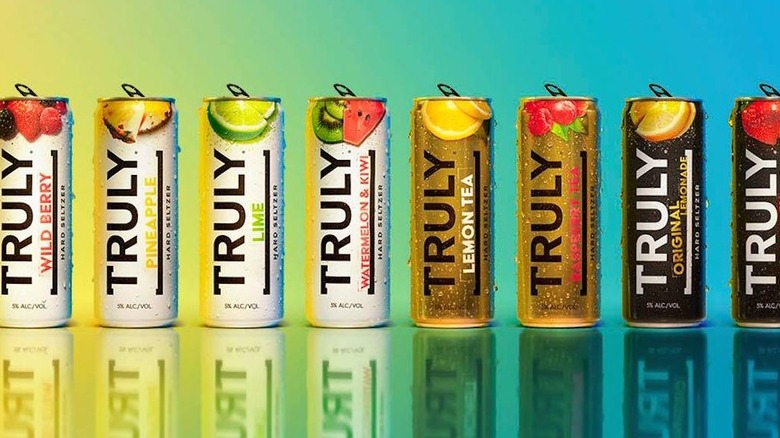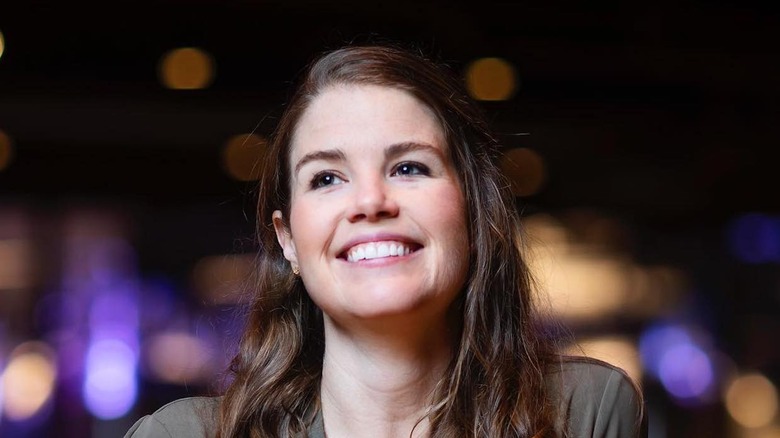Truly Hard Seltzer's Casey O'Neill Explains What Hard Seltzer Really Is - Exclusive
Hard seltzer first emerged in 2013 and has since been heralded as the official drink of summer (via Vox). In fact, over half of American drinkers now have a hard seltzer at least once per week, according to a report by International Wine and Spirit Research. Sales of the slim, colorful cans account for 10% of all sales of beer, hard ciders, and flavored malt beverages, NielsonIQ shows. That said, hard seltzer is not beer. Nor is it hard cider. And it's definitely not a wine cooler.
So, then, what exactly is hard seltzer? To find out, Mashed went straight to one of the forces behind hard seltzer's rise: Casey O'Neill, the Boston Beer Company's Director of Product Development. O'Neill came up with the idea for Truly Hard Seltzer back on a summer evening in 2015. She and a few friends were looking to kick back with some light, ready-to-drink alcoholic refreshments after a CrossFit workout, only to discover their options were limited to beer, wine, and sugar-sweetened malt beverages. That's when O'Neill was inspired to create a lightly-spiked sparkling water — kind of like LaCroix but with a "kick." And that's exactly what she and her Boston Beer colleagues went on to do, and in the process, they helped define what "hard seltzer" really is.
When it comes to hard seltzer, it's about accessibility and refreshment
In 2015, Casey O'Neill, who was working in research and development at The Boston Beer Company, realized that what was missing from the alcoholic beverage market was the spiked equivalent of a simple, flavored sparkling water. The result was Truly Hard Seltzer, which launched in 2016.
Technically, "hard seltzer" is defined as carbonated water mixed with any alcohol base, including wine, malt, and distilled spirits, per BevSource. However, most hard seltzers, including Truly Hard Seltzer, are made from fermented cane sugar, which offers the most neutral "canvas" on which to build flavor, O'Neill told Mashed.
"Some of the sort of key parameters of ... what defines the category for hard seltzer are accessibility and refreshment," O'Neill explained. "A lot of things might also fall into that category, but it's accessibility and refreshment plus simple, natural ingredients." Given those parameters, O'Neill says "that knocks out quite a few of the flavored malt beverages out there."
Though it's still alcohol, hard seltzer has gained a "healthier" image due to its simple ingredients. It's low in sugar (and generally hovers around 100 calories), which you'll see reflected on the label. In fact, nutrition information is not something you'll typically see on a lot of flavored malt beverages. O'Neill also pointed to hard seltzer's "sessionable ABV," which is 5% for a 12-ounce can. That means the alcohol content is low enough to make hard seltzers suitable for sipping over an extended period — perfect for lazy beach days or after a long hike (via Collins Dictionary). This brings us to another defining characteristic: There's absolutely no need for a bottle opener.
Truly Hard Seltzer is set to launch some fun and refreshing new flavors in the future. So be on the lookout for what this creative beverage line, led by Casey O'Neill, is going to surprise us with next.

